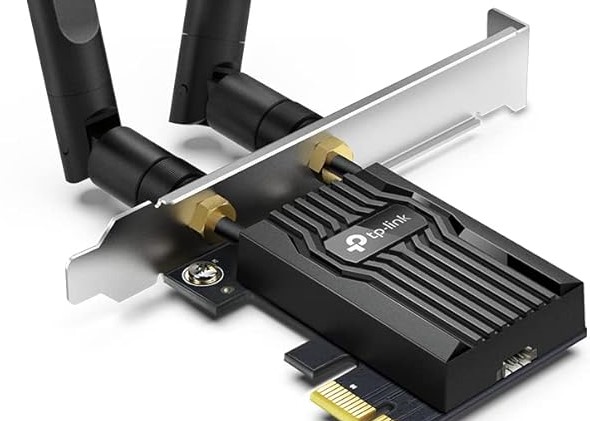TP-Link AX3000

One of the best ways to improve the reliability and performance of your wireless network to to upgrade all devices to use at least Wi-Fi 6 (upgrade your router / access points first). Wi-Fi 6, also called 802.11ax, was a monumental improvement over the older standards.
When I am refurbishing older PCs I like to use the TP-Link AX3000 network card. Its an inexpensive way to get the benefits of the newer standard and also add Bluetooth connectivity for modern wireless mice and keyboards.
Wi-Fi 6 introduces several major technological advancements over Wi-Fi 5 (802.11ac) and earlier standards. These improvements enhance speed, efficiency, capacity, and reliability, making it particularly beneficial in environments with many connected devices. Here's a breakdown:
Key Technological Improvements in Wi-Fi 6
Higher Speeds
- Wi-Fi 6: Supports theoretical speeds up to 9.6 Gbps compared to 3.5 Gbps for Wi-Fi 5.
- Improvement: Uses higher-order modulation (1024-QAM vs. 256-QAM in Wi-Fi 5), allowing more data to be transmitted per signal.
Better Efficiency with OFDMA (Orthogonal Frequency Division Multiple Access)
- Wi-Fi 6: Allows multiple devices to share a single channel by dividing it into smaller subchannels.
- Benefit: Reduces latency and increases efficiency, especially in high-density environments like offices and apartment complexes.
MU-MIMO (Multi-User Multiple Input, Multiple Output) Expansion
- Wi-Fi 6: Supports both uplink and downlink MU-MIMO for communication with multiple devices simultaneously (Wi-Fi 5 only supports downlink MU-MIMO).
- Benefit: Improves network performance for multiple connected devices, reducing bottlenecks.
Target Wake Time (TWT)
- Wi-Fi 6: Allows devices to schedule communication times with the router, reducing the need to remain constantly awake.
- Benefit: Extends battery life for IoT devices, smartphones, and other wireless devices.
Increased Capacity
- Wi-Fi 6: Designed to handle many more devices efficiently.
- Improvement: Combines OFDMA and MU-MIMO to optimize traffic even in crowded networks.
Improved Signal Reliability with BSS Coloring
- Wi-Fi 6: Uses Basic Service Set (BSS) Coloring to distinguish signals from neighboring networks.
- Benefit: Reduces interference in congested areas, improving reliability and performance.
Wider Channels and More Bandwidth
- Wi-Fi 6: Can utilize 160 MHz channels, doubling the bandwidth compared to 80 MHz in Wi-Fi 5.
- Benefit: Boosts speed and reduces congestion on supported devices.
Backward Compatibility and Transition Benefits
- Wi-Fi 6: Fully backward compatible with Wi-Fi 5 and earlier standards.
- Benefit: Ensures smooth transitions and supports mixed environments of old and new devices.
Real-World Benefits
- For Businesses: Improved performance in offices with high device density and better support for IoT devices.
- For Homes: Enhanced streaming quality, lower latency for gaming, and smoother operation of smart home devices.
- In Public Spaces: Better network performance in stadiums, airports, and other crowded areas.
Comparison Summary
| Feature | Wi-Fi 5 | Wi-Fi 6 |
|---|---|---|
| Maximum Speed | Up to 3.5 Gbps | Up to 9.6 Gbps |
| MU-MIMO | Downlink only | Uplink and Downlink |
| OFDMA | No | Yes |
| TWT | No | Yes |
| BSS Coloring | No | Yes |
| Channels | Up to 80 MHz | Up to 160 MHz |
Wi-Fi 6 brings substantial improvements in speed, capacity, and efficiency, making it a future-proof choice for modern networks. Let me know if you'd like further details!